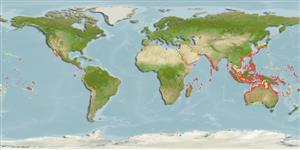Environment: milieu / climate zone / depth range / distribution range
Écologie
marin récifal; profondeur 4 - 35 m (Ref. 90102). Tropical
Indo-West Pacific: Red Sea and East Africa to Fiji, north to southern Japan, south to southeast Australia and New Caledonia. Recently recorded from Tonga (Ref. 53797).
Taille / Poids / Âge
Maturity: Lm ? range ? - ? cm
Max length : 12.0 cm TL mâle / non sexé; (Ref. 2334)
Épines dorsales (Total): 5; Rayons mous dorsaux (Total): 17-21; Épines anales 0; Rayons mous anaux: 17 - 21; Vertèbres: 32 - 33. Post-pelagic are almost fully transparent and more slender compared to those established in the benthic phase. Variable in color from black to red and yellow, usually in a mix of bands and spots (Ref. 48635). Total body number of plates 31-35. Caudal fin truncate, rounded or lanceolate. Caudal fins of females modified into brood pouch (Ref. 9829).
Adults usually settle along reef edges in current-prone areas (Ref. 48635). Uncommon species found solitary or paired, among branches of gorgonians, floating weeds, or crinoids (Ref. 9710). They feed mostly on mysids but also target small benthic shrimps (Ref. 48635). Females carry the eggs in their pelvic fins that are modified to form a brood pouch (Ref. 205).
Life cycle and mating behavior
Maturité | Reproduction | Frai | Œufs | Fécondité | Larves
Pelvic fins of females are modified as brood pouch for the reception of the eggs (Ref. 205).
Randall, J.E., G.R. Allen and R.C. Steene, 1990. Fishes of the Great Barrier Reef and Coral Sea. University of Hawaii Press, Honolulu, Hawaii. 506 p. (Ref. 2334)
Statut dans la liste rouge de l'IUCN (Ref. 130435)
Menace pour l'homme
Harmless
Utilisations par l'homme
Pêcheries: sans intérêt; Aquarium: Aquariums publics
Plus d'informations
RéférencesAquacultureProfil d'aquacultureSouchesGénétiqueElectrophoresesHéritabilitéPathologiesTraitementNutrientsMass conversion
CollaborateursImagesStamps, Coins Misc.SonsCiguateraVitesseType de nageSurface branchialeOtolithesCerveauxVision
Outils
Articles particuliers
Télécharger en XML
Sources Internet
Estimates based on models
Preferred temperature (Ref.
123201): 20.9 - 29, mean 27.7 °C (based on 626 cells).
Phylogenetic diversity index (Ref.
82804): PD
50 = 0.5312 [Uniqueness, from 0.5 = low to 2.0 = high].
Bayesian length-weight: a=0.01000 (0.00244 - 0.04107), b=3.04 (2.81 - 3.27), in cm total length, based on all LWR estimates for this body shape (Ref.
93245).
Niveau trophique (Ref.
69278): 3.6 ±0.59 se; based on food items.
Fishing Vulnerability (Ref.
59153): Low vulnerability (10 of 100).
Nutrients (Ref.
124155): Calcium = 129 [75, 249] mg/100g; Iron = 0.917 [0.508, 1.656] mg/100g; Protein = 17.9 [16.7, 19.1] %; Omega3 = 0.123 [0.068, 0.224] g/100g; Selenium = 35.3 [16.7, 82.4] μg/100g; VitaminA = 90.1 [29.4, 266.4] μg/100g; Zinc = 1.93 [1.27, 2.76] mg/100g (wet weight);
